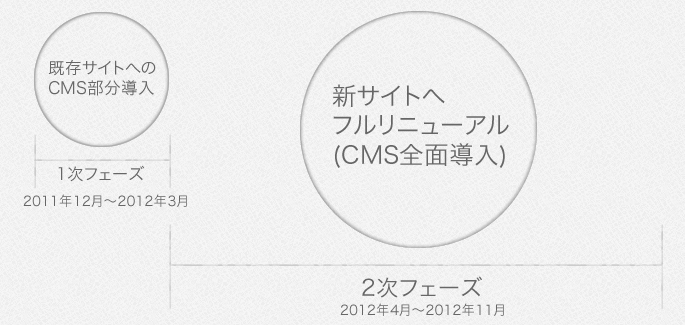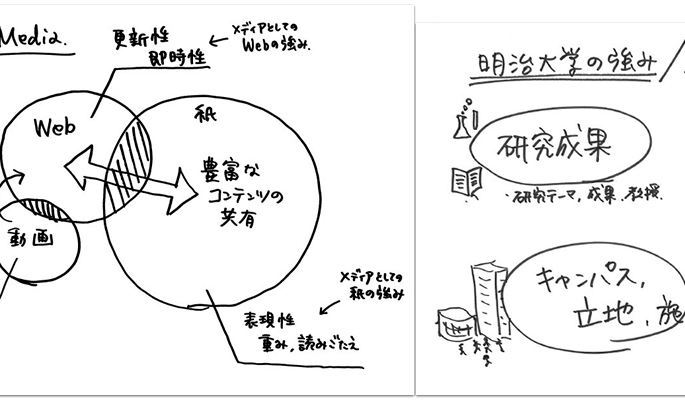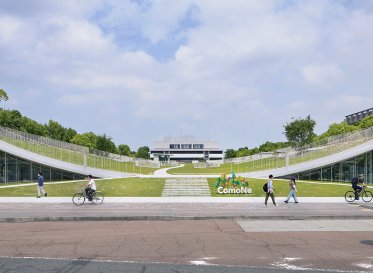
Meiji University CMS Introduction: Overall Renewal
Entirely rethinking the special sites that have been popping up en masse, and starting a revolution in information transmission university-wide that is alignment with this
In 2011, Meiji University celebrated its 130th year. Until now, the websites were independently created by each faculty and department; the start of an authentic university website was apparently in the latter half of the 1990s. However, despite a feeling of limitation in terms of site operations, this university which held issues from a PR strategy perspective planned a total renewal of its site to coincide with its 130th anniversary.
In addition to the first introduction of CMS, how do we guide a highly difficult project to success that includes transition work which spanned 8,000 pages, and a large number of stakeholders? The solution to this issue is reflected back upon in interviews with: Professor Yutaka Utashiro (Faculty of Business Administration), who works as the Vice-Chief of the Meiji University PR centre and is a specialist at the Meiji University’s President’s Office Koji Shiraishi, member of the Public Relations section of the Corporate Planning Department of Meiji University, Kohei Takizawa, who is the Loftwork chief director who managed this project.

Kohei Takizawa (hereafter, “Takizawa”) In terms of the background to the renewal, I’ve heard that there were major issues on the operations front; what would you say the situation was in a concrete fashion?
Yutaka Utashiro (hereafter, “Utashiro”) We felt a sense of danger that if we weren’t able to transition to a new operational foundation to coincide with our 130th anniversary, the university’s Web PR would end up lagging far behind other universities. Amongst these circumstances, within the university, a PR strategy HQ had been started up, and a PR centre had followed shortly afterwards. Creating a system in which the academic and corporate institutions could join together in considering PR strategy and working toward university-wide consensus while advancing the progress of projects was the major motivation that boosted the renewal.

Koji Shiraishi (hereafter, “Shiraishi”) The previous site was also decently set up in terms of the structure of the overall framework, but special sites and suchlike had popped up everywhere, and this led to a lack of a feeling of unification of the site overall. As well as sometimes lacking stories in line with the university’s academic changes policies, which promoted the academic, research and social contributions of the university, there was also the issue of very different structuring.There were differences between different faculties of the “temperature”, as it were, of their PR, and while there was the presumption of distributed management by the various faculties and departments, there were different levels of skills between the employees responsible for carrying out these tasks, as well as frequent personnel changes.
An uneven level of literacy and differences in motivation were problems which posed extreme difficulty. In terms of technology as well, we’d barely managed up till that point using commercial homepage creation software to maintain our site, but considering the large size of the site, we were finding that we were fast reaching the limits of the software.
On the other hand, Meiji University’s globalization progress and strengthened research and suchlike policies that had been launched on the academic side were not able to be effectively promoted on the Web. We needed to transmit to society the university’s initiatives towards academic changes, in a fashion that could be seen with the eyes. One could say that for that purpose, we had reached a time in which we needed to reconsider how to present ourselves on the Web.
Slow and steady wins the race! For the second phase, via a renewal separated into stages, “Lean Startup”was put into practice
Takizawa It was in November 2010 that my company became involved and the project started. Please tell me candidly what the reasons were for choosing Loftwork.
Utashiro Loftwork understood what Meiji University was trying to achieve, and proposed the best way of proceeding with the overall project, as well as the most appropriate CMS product(WebRelease 2). Additionally, as it was a foundation that we could continue to use in the mid/long-term, there was a priority placed on the actual results of large-scale site renewal, the transition work to CMS, and full CMS introduction.
Takizawa Thank you. My impression was that, as the concept was firmly structured, it was easy to make a proposal as well as to create an order of priority. There’s a tendency in those circumstances to focus on the volume of work required and to neglect what needs to be expressed, but that wasn’t an issue here. In terms of making progress, it wasn’t a case of suddenly renewing everything at once, but rather a two-phase deployment was decided upon; the first phase involved leaving the design as it was and using CMS in the back-end, and the second phase involved making progress with migrating the existing content to CMS while incorporating the new design.
Utashiro From the two perspectives of time and volume, it was decided that it was necessary to distribute the workload. Firstly, the foundations were laid and a path was created to bring out information in rapid succession within the framework of the new mechanisms; only the parts which physically needed to be transitioned were done in bulk in one go. The visibly renewed part was to be brought out later, after having had some time for careful deliberation.

This is exactly what the“Lean Startup”is that Loftwork progressed. Firstly, firmly structure the parts that needed to be done, and then make progress in staged with the +α parts. But we didn’t have the practical know-how needed in terms of how to express that in a technological fashion, so that was hammered out via our interaction with Loftwork.
Success factor was that we're able to choose the best path of progress, which would benefit us in the long run
Takizawa Now, in hindsight, would you say that splitting it into two phases was the correct decision?

Shiraishi It was the best decision in terms of implementing operations that were as gentle as possible to the actual people involved as well. More than anything, managers within the university were able to gain time to get used to the new method of information transmission.Summarily, it was the method which would benefit us the most in the long run in terms of each user happily using CMS. I think that this was a big success factor.
Takizawa For Loftwork, to avoid detours and duplication as much as possible, we eliminated overlapping work, and made adjustments so that we would be able to proceed to the second phase in an effective fashion. Additionally, unlike the first phase where the main concentration was on systems, the second phase also involved design, and consideration was thus required in terms of what direction to proceed in.
With the meanings of “this is a phase that makes your brain go a bit soft” and “let’s change switches”, we tried handwriting proposals, and got students to participate in feedback sessions so that we could learn more about our targets, and suchlike; it was an initiative that we enjoyed being involved in.

What really struck me at the feedback sessions was that the students were very aware of the state of the university site and faculty sites – more so than we had expected. Establishing “people” as the centre of the concept and reflecting this upon the design was also strengthened by our feeling of “we want to focus on people!” as we spoke with students.
Establishing a foundation that realistically and continuously conveys a constantly changing university
Takizawa In this project, there was constant discussion amongst everyone about various things, and a lively feeling that we were making something together. The design was not typical of Meiji university, or a design that placed importance on the dignity of the university, but rather an adventurous, playful design. Thanks to this, I think it made it easier to focus on people, and resulted in the creation of a , in the best sense of the word, ‘raw’ site. It was a real challenge to remove information on entrance exams from global navigation. How do you feel about this?

Utashiro ‘We want to realistically convey a constantly changing university.’ It was our desire to incorporate this into RFP as well. When you talk about company sites, it is not about creating specs, but rather how to enjoy the site, and how it is to use, that is more important. In our situation, we need to continually transmit raw information about people and activities.
This is why CMS was introduced. Using the structure called CMS, we are able to press forward during operation with the primary goal of ‘making people and activities visible.’ Judging by students’ tweets, it seems that the redesign has been accepted extremely favorably. I think the fact that it is not formal, but rather down-to-earth, with current students actually on the site’s top image, is great.
With the introduction of CMS, on-site supervisors’ literacy, and awareness of Web information has grown significantly

Takizawa It is wonderful how you have not only created a structure, but also how you have established the operation of CMS in the field. You are not only training people how to use it, but also implementing briefings in order to enforce the fact that CMS has been introduced. It is extremely rare for people to go that far in the initial setup. It is usually an area which is easy to slack off on.
I realized that in many various situations, you have communicated well within the university, and gained real acceptance and understanding. Could you tell us in detail what kind of schemes were devised?

Shiraishi Up till now, there was a lack of operational support, such as briefings, in the university. Therefore many areas of the site were fraying. We learned from that and came up with a strategy to penetrate the field, and continually used keywords such as ‘CMS’ and ‘WebRelease.’ It was also the first time we implemented briefings and workshops for supervisors at 3 campuses. As a result users increased, with there currently being approximately 260 users. They are all using it actively and in regards to information, it has become easier to work together with various staff members.
Through the redesign, great results such as improved literacy of supervisors in the field, and the increased awareness of the homepage and Web information were achieved. Of course this was a by-product of being able to achieve the original redesign goals, such as creating the unionization of the site’s basic structure, the arrangement of hard to understand content conductors, and the establishment of a style that follows university policy. Having said that, it feels like the university homepage has also just arrived at the start line. This is finally the start.
 Created 2 manuals, one for supervisors and one for operators, and implemented workshops on each campus.
Created 2 manuals, one for supervisors and one for operators, and implemented workshops on each campus.
Takizawa Since we are on the topic of achievement, if there are any assessment indicators, could you please tell us about them?
Utashiro There are no specific quantifiable indicators. The purpose of this redesign is not to verify results. More than expecting a direct result, I expect an indirect result that slowly manifests itself. I intend to observe this closely. I would like to understand and continually analyze how our university home page is being looked at by using the access log etc, and then use the information to improve the relationship.
Continue to boldly take on new challenges while at the same time keeping an eye on the relationship with social media
Takizawa Regarding the factors behind this project’s success, how have you analyzed it?
Shiraishi We have been blessed with good ‘people.’ More than anything, being able to come this far together with a wonderful director like Takizawa. Also, without the participation of the Information Center Vice President, Utashiro, who has a great academic understanding of on-campus matters, the dedicated cooperation of all supervisors, especially the clerical system section, and the arrival of new graduate Web specialists to the public relations section, we would not have succeeded. Also, practically, being able to introduce CMS smoothly to the whole university in the first stage. I think 80% of the project was promised at this stage. I feel it was so important to have been able to completely change the operational base in this redesign.

Takizawa Thank you (haha). Finally, please tell us about the outlook for the future.
Shiraishi With the Web as the driving force, and while continuing to think about the relationship with social media, the main challenge will be how to get each stakeholder involved in university activities. For specific ideas on this area we are expecting a lot from suggestions from Loftwork, which possess a wealth of experience and knowledge about the Web and social media.
Utashiro Universities must continue to change. Therefore, you could say that this is an experiment. As we continue to experiment, it would be great if we can get it to progress in the right direction.
Takizawa Loftwork would also like to think hard about the new future challenges facing Meiji university. Thank you for the valuable discussion today.
※ contents, customer information, responsible director information is at the time of this article release. Currently it may be different.
Related projects










